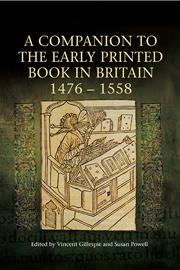Book contents
- Frontmatter
- Contents
- List of Illustrations
- List of Contributors
- Preface
- Acknowledgements
- Abbreviations
- Chronology of the Period
- Introduction
- I THE PRINTED BOOK TRADE
- II THE PRINTED BOOK AS ARTEFACT
- III PATRONS, PURCHASERS AND PRODUCTS
- 7 Merchants
- 8 The Laity
- 9 The Secular Clergy
- 10 The Regular Clergy
- 11 Universities, Colleges and Chantries
- IV THE CULTURAL CAPITAL OF PRINT
- Index of Manuscripts
- Index of Printed Books
- General Index
8 - The Laity
from III - PATRONS, PURCHASERS AND PRODUCTS
Published online by Cambridge University Press: 05 April 2014
- Frontmatter
- Contents
- List of Illustrations
- List of Contributors
- Preface
- Acknowledgements
- Abbreviations
- Chronology of the Period
- Introduction
- I THE PRINTED BOOK TRADE
- II THE PRINTED BOOK AS ARTEFACT
- III PATRONS, PURCHASERS AND PRODUCTS
- 7 Merchants
- 8 The Laity
- 9 The Secular Clergy
- 10 The Regular Clergy
- 11 Universities, Colleges and Chantries
- IV THE CULTURAL CAPITAL OF PRINT
- Index of Manuscripts
- Index of Printed Books
- General Index
Summary
Although we tend to see the demand for private reading as fuelling the work of early printers, it may be more correct to imagine printing's beginnings as spurred by what James Raven has called ‘a demand for objects viewed as worthy of possession’. These printed objects may not have been books, or if they were, may not have been books intended primarily for private reading. Three categories of early printing, in their great popularity, can illustrate what products of the press were early seen as valuable by a lay audience: indulgences, almanacs/calendars, Books of Hours. Patterns of publication show their widespread appeal and in the first part of this chapter we will examine these desirable kinds of early printing. Later and more conventionally, we will turn to books intended for private reading, focusing on the surviving volumes that belonged to a small group in the first thirty years after printing came to England, between 1476 and 1509. This is Margaret Beaufort's circle – a mixed company of aristocrats and gentry, male and female readers, who were connected to the king's mother by ties of blood or friendship or employment, and whose books give a collective sense of printing's first English lay readership.
- Type
- Chapter
- Information
- A Companion to the Early Printed Book in Britain, 1476-1558 , pp. 134 - 149Publisher: Boydell & BrewerPrint publication year: 2014

